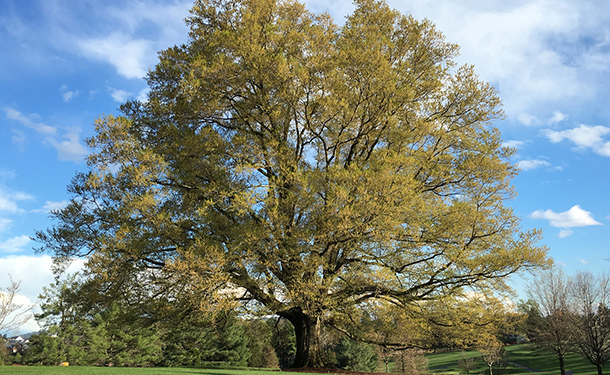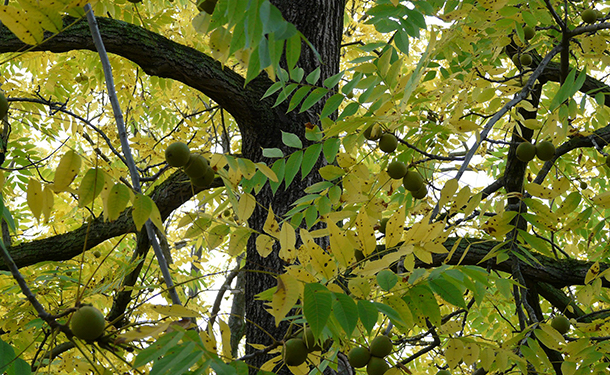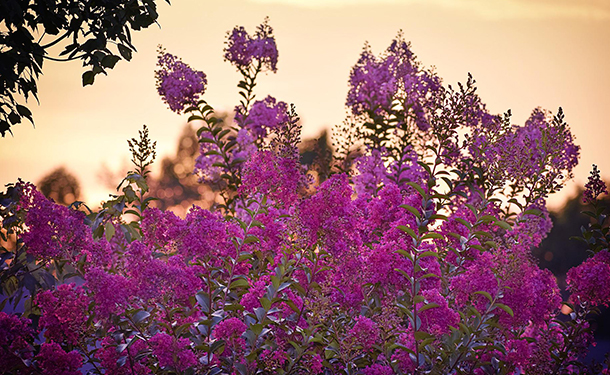Avoid planting a tree that will destroy your driveway and cost thousands of dollars to your home’s foundation. Knowing which trees have non-invasive roots will help you plant the right species in your yard.

thetreecareguide.com gathered essential information on five tree species that have non-invasive root systems and can be safely planted around your home and hardscape.
What are Non-Invasive Roots?
Non-invasive root systems (as the name implies) are less likely to grow beneath and interfere with sidewalks, sewers, or your home’s foundation.
Even trees with non-invasive roots should still be planted 8 to 10 feet from your home or other structure that could interfere with the tree’s growth or care. While the following tree species are not known to have invasive root systems, they should still be planted with sufficient space to permit their growth to full maturity:
1. White Oak (Quercus alba)

White oaks are large, strong, imposing trees. They have short, stocky trunks with massive horizontal limbs. The wide-spreading branches form an upright, well-rounded crown.
Mature Size – At maturity, this species reaches heights of 50 to 80 feet with a spread of 50 to 80 feet.
Sun – This tree species prefers full sun but has a moderate tolerance to partial shade. It is more shade tolerant in its youth and less tolerant as it grows larger.
Soil Type and pH – White oaks can adapt to a variety of soil textures but prefer deep, moist, well-drained sites. This species thrives in soils with a pH of 5.5 to 8.0.
Water Requirement – Young and mature oak trees require little watering, only once a month.
USDA Hardiness Zone – 3 through 9
2. Eastern Black Walnut (Juglans nigra)

This species is a tall tree of the walnut family (Juglandaceae). It is native to eastern North America and prized for its decorative wood. Black walnut’s dark, fine-grained wood is commonly used in furniture, paneling, and gunstock production.
Mature Size – At maturity, this species reaches heights of 50 to 75 feet with a spread of 50 to 75 feet.
Sun – This species thrives in full sun with at least six hours of direct sunlight every day.
Soil Type and pH – Eastern black walnut grows best on deep, well-drained, nearly pH-neutral (6.5 to 7.2) soils that are fertile and moist but not wet.
Water Requirement – Water well-established walnuts every two to three weeks.
USDA Hardiness Zone – 4 through 9
3. Crabapple (Malus)

The crabapple is a small, deciduous, fruit-bearing tree found primarily in the temperate zones of the Northern hemisphere.
Mature Size – At maturity, crabapples reach heights of 10 to 25 feet with a spread of 10 to 25 feet.
Sun – This species needs at least six hours of sun a day to guarantee ample blossoming and fruiting.
Soil Type and pH – Crabapples thrive in rich loam-type soil (a combination of clay, silt, and sand). Good drainage is a must for tree health, and the soil should be moist, slightly acidic, and with a 5.0 to 6.5 pH.
Water Requirement – Once established, crabapples are drought tolerant and should not need any supplemental watering unless the season is considerably dry.
USDA Hardiness Zone – 3 through 8
4. Japanese Maple (Acer palmatum)

Small deciduous Japanese maple trees are highly prized for their delicate and colorful foliage throughout the growing season and fall.
Mature Size – At maturity, this species will reach heights of 15 to 25 feet with a spread of 20 feet.
Sun – Japanese maple trees prefer to grow in partial shade with about four hours of direct, unfiltered sunlight per day.
Soil Type and pH – Japanese maples grow in acidic (5.5 to 6.5 pH), loamy, moist, rich, sandy, silty loam, well-drained, and clay soils. The species prefers moist, well-drained soil conditions but is somewhat drought tolerant.
Water Requirement – It’s good to water your Japanese maple tree a few gallons every other day.
USDA Hardiness Zone – 5 through 8
5. Crape Myrtle (Lagerstroemia)

Crape myrtles are deciduous, small to medium-sized trees with a variable, moderately dense habit, often multi-stemmed form. The tree’s showy flowers have wrinkled petals like crepe paper. The species’ foliage is typically dark green changing to yellows, oranges, and reds in autumn.
Mature Size – At maturity, this species will reach heights of 15 to 25 feet with a spread of 6 to 15 feet.
Sun – Crape myrtle trees need full sun (6 or more hours per day) to thrive.
Soil Type and pH – Crape Myrtles can be grown all over the USA in any soil type and will thrive in an acidic to slightly acidic soil ranging from 5.0 to 6.5 pH.
Water Requirement – This species needs at least one inch of water per week.
USDA Hardiness Zone – 7 through 10
Tree Species with Non-Invasive Root Systems
In this article, you discovered five tree species that can be safely planted in your yard without worrying about your driveway, sidewalk, street, or foundation being broken up by invasive roots.
Planting trees with non-invasive roots allows you to grow a beautiful yard and benefit from your trees, providing shade and shelter from bad weather conditions.
Planting trees with invasive root systems will have you repairing costly damages as they will lift and crack driveways, foundations, sidewalks, and streets.
Sources:
naturalresources.extension.iastate.edu/forestry/iowa_trees/trees/white_oak.html
naturewalk.yale.edu/trees/juglandaceae/juglans-nigra/eastern-black-walnut-59
hgic.clemson.edu/factsheet/crabapple/
plants.ces.ncsu.edu/plants/acer-palmatum/
arborday.org/trees/treeguide/treedetail.cfm?itemID=824